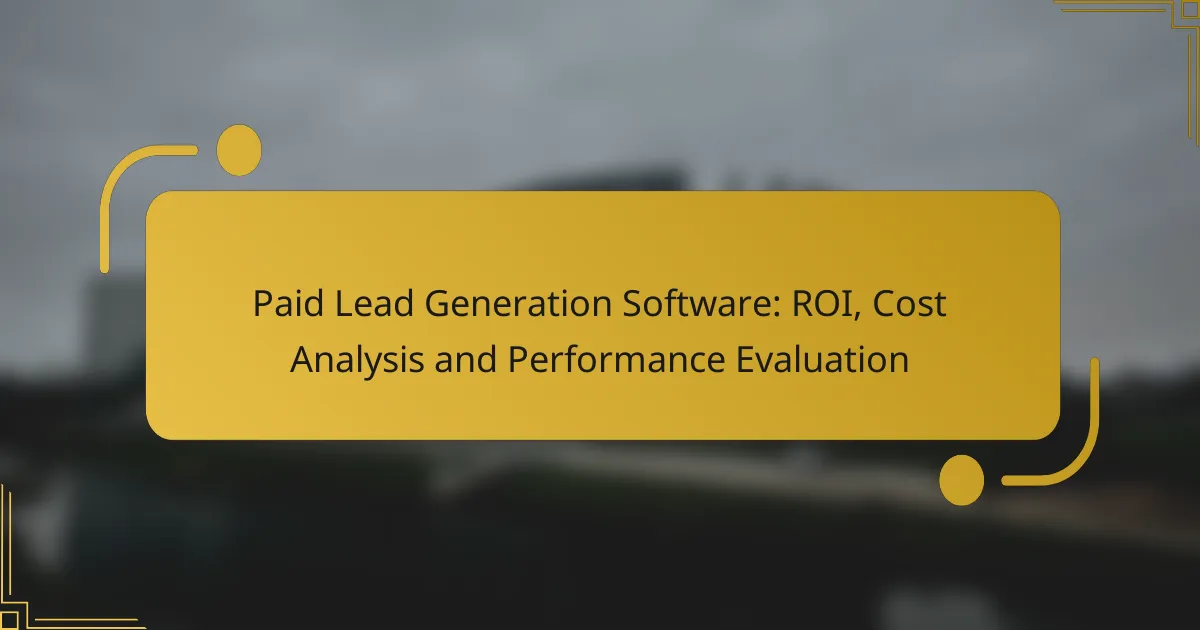Paid lead generation software plays a crucial role in enhancing marketing efficiency by attracting high-quality leads tailored to specific business needs. By utilizing targeted strategies and data analytics, companies can optimize their ROI while managing costs effectively. Understanding the associated expenses, such as subscription fees and integration costs, is essential for evaluating the overall performance and ensuring a successful investment in lead generation tools.

What are the best paid lead generation software options?
The best paid lead generation software options include HubSpot, Salesforce, Marketo, Leadfeeder, and LinkedIn Sales Navigator. Each of these platforms offers unique features tailored to different business needs, making them suitable for various industries and company sizes.
HubSpot
HubSpot is a comprehensive inbound marketing platform that includes tools for lead generation, email marketing, and CRM. It allows users to create landing pages, forms, and email campaigns that attract and convert leads effectively.
One of HubSpot’s strengths is its user-friendly interface, which makes it accessible for businesses of all sizes. Pricing typically starts with a free tier, but advanced features may require a subscription ranging from low hundreds to thousands of USD per month, depending on the plan.
Salesforce
Salesforce is a leading CRM platform that offers robust lead generation capabilities through its Sales Cloud. It enables businesses to track leads, manage customer relationships, and automate marketing processes.
Salesforce’s customization options are extensive, allowing businesses to tailor the software to their specific needs. However, the cost can be significant, with plans often starting in the mid hundreds of USD per month and scaling up based on additional features and user licenses.
Marketo
Marketo, now part of Adobe, specializes in marketing automation and lead management. It provides tools for email marketing, lead nurturing, and analytics, helping businesses to engage leads throughout the sales funnel.
Marketo is particularly suited for larger enterprises with complex marketing needs. Pricing is typically on the higher end, often starting in the low thousands of USD per month, reflecting its advanced capabilities and scalability.
Leadfeeder
Leadfeeder focuses on identifying website visitors and turning them into leads. It integrates with Google Analytics to provide insights into which companies are visiting your site, allowing for targeted follow-up.
This tool is particularly useful for B2B companies looking to convert anonymous traffic into actionable leads. Pricing is generally affordable, with plans starting in the low hundreds of USD per month, making it accessible for small to medium businesses.
LinkedIn Sales Navigator
LinkedIn Sales Navigator is designed for sales professionals to find and connect with potential leads on LinkedIn. It offers advanced search capabilities, lead recommendations, and integration with CRM systems.
This platform is ideal for B2B lead generation, leveraging LinkedIn’s vast professional network. Pricing typically starts around low hundreds of USD per month, which can be a worthwhile investment for businesses focused on building relationships in a professional context.

How does paid lead generation software improve ROI?
Paid lead generation software enhances ROI by optimizing marketing efforts to attract high-quality leads more efficiently. By leveraging targeted strategies and data analytics, businesses can reduce costs while increasing the likelihood of converting leads into customers.
Targeted audience reach
Paid lead generation software allows businesses to precisely target their ideal audience based on demographics, interests, and behaviors. This targeted approach minimizes wasted ad spend and ensures that marketing messages reach individuals most likely to convert.
For example, platforms like Google Ads and Facebook Ads enable users to set specific criteria for audience targeting, which can lead to a higher engagement rate and better ROI. Businesses should regularly review and adjust their targeting parameters to align with changing market conditions.
Data-driven decision making
Utilizing data analytics tools within paid lead generation software empowers businesses to make informed decisions about their marketing strategies. By analyzing metrics such as click-through rates, conversion rates, and customer acquisition costs, companies can identify what works and what doesn’t.
For instance, A/B testing different ad creatives or landing pages can reveal which variations yield better results, allowing businesses to allocate their budgets more effectively. Regularly monitoring performance data is crucial for continuous improvement and maximizing ROI.
Enhanced conversion rates
Paid lead generation software can significantly improve conversion rates by streamlining the customer journey. By providing targeted content and personalized experiences, businesses can engage leads more effectively, increasing the likelihood of conversion.
Implementing features such as retargeting ads and optimized landing pages can further enhance conversion rates. Businesses should focus on creating compelling calls to action and ensuring that their landing pages are user-friendly and relevant to the ad content.

What are the costs associated with lead generation software?
The costs associated with lead generation software typically include subscription fees, setup and integration costs, and training and support expenses. Understanding these costs is crucial for evaluating the overall return on investment (ROI) and ensuring effective budget allocation.
Subscription fees
Subscription fees are the recurring costs for using lead generation software, often billed monthly or annually. These fees can vary widely based on the features offered, ranging from low tens of USD for basic plans to several hundred USD for more comprehensive solutions.
When selecting a subscription plan, consider the number of users, the volume of leads, and any additional functionalities you may need. It’s advisable to compare different providers to find a plan that aligns with your budget and requirements.
Setup and integration costs
Setup and integration costs refer to the expenses incurred when initially implementing the software and connecting it with existing systems. These costs can range from a few hundred to several thousand USD, depending on the complexity of the integration and the level of customization required.
To minimize these costs, evaluate software that offers straightforward integration processes or built-in compatibility with your current tools. Consider seeking vendors that provide clear documentation and support during the setup phase.
Training and support expenses
Training and support expenses are associated with educating your team on how to effectively use the lead generation software. These costs can include formal training sessions, online resources, or ongoing support, which may add up to hundreds of USD annually.
Investing in proper training is essential to maximize the software’s potential. Look for vendors that offer comprehensive training programs and responsive customer support to ensure your team can utilize the software efficiently and troubleshoot any issues that arise.

How to evaluate the performance of lead generation software?
To evaluate the performance of lead generation software, focus on metrics that measure effectiveness and cost-efficiency. Key indicators such as customer acquisition cost and return on ad spend provide insights into how well the software converts leads into customers while managing expenses.
Key performance indicators (KPIs)
Key performance indicators (KPIs) are essential metrics that help assess the effectiveness of lead generation software. Common KPIs include conversion rates, lead quality, and the number of leads generated over a specific period. Tracking these metrics allows businesses to identify strengths and weaknesses in their lead generation strategies.
For example, a conversion rate of 10% might indicate a strong lead generation process, while a rate below 5% could signal the need for improvements. Regularly reviewing KPIs helps in making informed adjustments to optimize performance.
Customer acquisition cost (CAC)
Customer acquisition cost (CAC) is the total cost associated with acquiring a new customer through lead generation efforts. This includes expenses related to marketing campaigns, software subscriptions, and personnel. A lower CAC indicates a more efficient lead generation process.
To calculate CAC, divide the total costs of acquiring customers by the number of new customers gained in a specific timeframe. For instance, if a company spends $10,000 in a month and acquires 100 new customers, the CAC would be $100. Keeping CAC in check is crucial for maintaining profitability.
Return on ad spend (ROAS)
Return on ad spend (ROAS) measures the revenue generated for every dollar spent on advertising. This metric is vital for evaluating the effectiveness of lead generation software in driving sales. A higher ROAS indicates that the advertising efforts are yielding good returns.
To calculate ROAS, divide the revenue generated from ads by the total ad spend. For example, if a business earns $5,000 from a campaign that cost $1,000, the ROAS would be 5:1. Aim for a ROAS of at least 4:1 to ensure that your lead generation efforts are financially viable.

What factors should be considered when choosing lead generation software?
When selecting lead generation software, key factors include your business size, industry requirements, integration capabilities, and user experience. Evaluating these aspects helps ensure the software aligns with your operational needs and enhances your lead generation efforts.
Business size and industry
Your business size and industry significantly influence the choice of lead generation software. Smaller businesses may benefit from cost-effective, user-friendly solutions, while larger enterprises might require more robust systems with advanced features. For example, a startup in the tech sector may prioritize software that offers scalability and automation, whereas a local service provider might focus on tools that facilitate direct customer engagement.
Additionally, consider industry-specific regulations or standards that may affect your lead generation strategies. For instance, businesses in finance or healthcare must ensure compliance with data protection regulations when handling leads.
Integration capabilities
Integration capabilities are crucial for seamless operation across your existing systems. Look for software that can easily connect with your customer relationship management (CRM) tools, email marketing platforms, and analytics software. This integration can streamline workflows and improve data accuracy, allowing for more effective lead tracking and nurturing.
Evaluate the software’s API availability and compatibility with other tools you currently use. A solution that offers pre-built integrations can save time and reduce the complexity of implementation.
User experience and support
A positive user experience is vital for maximizing the effectiveness of lead generation software. Ensure the interface is intuitive and that users can easily navigate the features. A well-designed dashboard can help your team quickly access important metrics and insights.
Additionally, consider the level of customer support provided by the software vendor. Responsive support can assist with troubleshooting and training, which is essential for optimizing the use of the software. Look for vendors that offer comprehensive resources, such as tutorials and live chat assistance, to enhance your team’s proficiency.

How can businesses optimize their lead generation strategies?
Businesses can optimize their lead generation strategies by leveraging data-driven insights, refining targeting methods, and integrating various marketing channels. This approach helps in maximizing return on investment (ROI) and improving overall performance.
Content marketing integration
Integrating content marketing into lead generation strategies enhances engagement and builds trust with potential customers. By creating valuable content that addresses the needs and pain points of the target audience, businesses can attract and nurture leads more effectively.
Consider using blog posts, whitepapers, and videos to provide informative content that showcases expertise. This not only helps in capturing leads but also positions the brand as a thought leader in the industry. Aim for a consistent publishing schedule to keep the audience engaged.
To optimize content marketing, utilize SEO best practices to increase visibility and drive organic traffic. Monitor performance metrics such as page views, time on page, and conversion rates to refine your approach. Avoid over-promoting products; instead, focus on providing genuine value to your audience.



